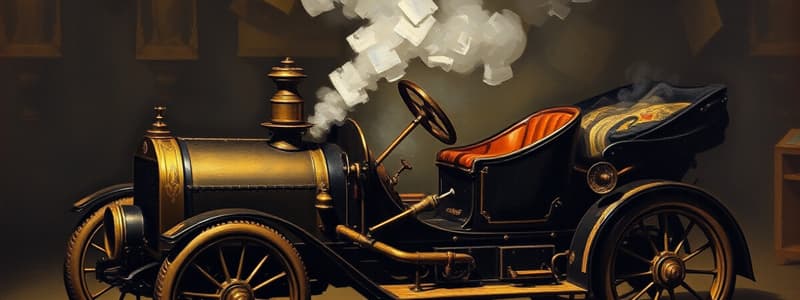Podcast
Questions and Answers
Who patented the first practical automobile for everyday use?
Who patented the first practical automobile for everyday use?
- François Isaac de Rivaz
- Carl Benz (correct)
- Nicolas-Joseph Cugnot
- Henry Ford
Electric cars became commercially available in the 2000s.
Electric cars became commercially available in the 2000s.
True (A)
How many wheels do most cars typically have?
How many wheels do most cars typically have?
four
The first steam-powered road vehicle was built by ______ in 1769.
The first steam-powered road vehicle was built by ______ in 1769.
Match the following cars with their significance:
Match the following cars with their significance:
What type of engine do most cars in use in the early 2020s rely on?
What type of engine do most cars in use in the early 2020s rely on?
Cars were adopted in Europe before they were widely used in the United States.
Cars were adopted in Europe before they were widely used in the United States.
Cars are primarily used for ______ transportation.
Cars are primarily used for ______ transportation.
Flashcards are hidden until you start studying
Study Notes
Car Overview
- Definition: A car, or automobile, is a motor vehicle primarily designed for road use, seating one to eight passengers, typically with four wheels.
- Global presence: Approximately one billion cars are currently in use worldwide.
- Importance: Cars are a crucial component of developed economies.
Historical Development
- 1769: Nicolas-Joseph Cugnot created the first steam-powered road vehicle.
- 1808: François Isaac de Rivaz designed the first internal combustion-powered automobile.
- 1886: Carl Benz patented the Benz Patent-Motorwagen, marking the invention of the modern car for everyday use.
Mass Production and Adoption
- Early 20th Century: The Oldsmobile Curved Dash (1901) and Ford Model T (1908) were the first mass-produced and mass-affordable cars, respectively.
- The United States saw a swift transition from horse-drawn carriages to automobiles.
- Post World War II: Car demand surged in Europe and other regions.
21st Century Trends
- Increasing usage of cars, particularly in rapidly developing countries like China and India.
- Continual expansion in features and controls in vehicles, enhancing complexity and passenger experience.
Engine Types and Future Trends
- Early 2020s: Most cars operate on internal combustion engines, relying on fossil fuels.
- Electric cars, initially invented early in automobile history, became commercially available in the 2000s.
- Projections suggest electric cars will cost less than traditional petrol-driven vehicles by 2025.
- Transition from fossil fuel-powered to electric vehicles is critical in climate change mitigation strategies, as highlighted by initiatives like Project Drawdown.
Studying That Suits You
Use AI to generate personalized quizzes and flashcards to suit your learning preferences.




